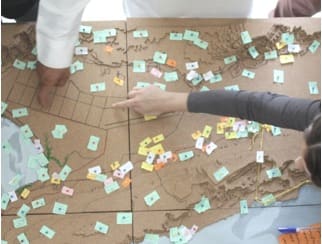
Review and Renew
Resources and tools for ongoing monitoring and learning
Methods / Approaches:
(Prioritize any customary or locally familiar methods)
There are many participatory, self-monitoring, evaluation and learning approaches that territory of life custodians may find useful, though all will have to be adapted to your context, and many communities may already have their own learning processes in place. Some among these options include the following:
Community-based monitoring – There are many ways that community members define and lead monitoring of their livelihoods and wellbeing, and the resources and territories they govern and manage. For example:
- Community-based monitoring and information systems (CBMIS) have been described as “initiatives by indigenous peoples and local community organisations to monitor their community’s well-being and the state of their territories and natural resources, applying a mix of traditional knowledge and innovative tools and approaches” (Ferrari et al, 2015) [here I was intending to link to Tebtebba’s Basic CBMIS online course/ training materials, but can’t find it online now?]
- The fairly comprehensive Community Monitoring Toolkit, designed to “support community monitoring groups and project officers” (based on experience in Australia), includes guidance, methods, and tools (such as templates) for planning and coordinating community-based environmental monitoring.
Other monitoring methods and approaches that might be considered include:
- Creating a public repository of accessible information about the territory of life and any relevant initiatives that community members may wish to monitor and learn from, can enhance learning and enable transparency.
- Public Hearing (or Public Audit) – Some communities may wish to organise periodic public hearings or audits to share and discuss information about the community bodies responsible for governing or managing resources. One example is provided by the Hariyo Ban Program and briefly described in this Internal Governance Tool 1 briefing. Here you can also read a more complete summary of the process, outcomes and lessons learned from public hearings and audits through this programme in Nepal (see Maharjan et al, 2006, Chapter 3).
See also relevant resources and tools above – e.g. SWOT/SWOL analysis, small and large group discussions, mapping, trend analysis, sketch interviews, transect walks, brainstorming and prioritization exercises, problem-tree analysis, situation analysis, etc.
Websites:
- The Monitoring Matters Network– “an international network of researchers and practitioners working with innovative approaches to monitoring of natural resources, livelihoods and governance”. The Network webpage includes basic information about what monitoring is and why it can be meaningful, examples of locally-based monitoring approaches, and links to publications about monitoring, including community-based natural resource monitoring, in addition to other resources.
Publications:
- An article titled ‘Community-based monitoring and information systems (CBMIS) in the context of the Convention on Biological Diversity (CBD)‘ describes a network of CBMIS – i.e. “initiatives by indigenous peoples and local community organisations to monitor their community’s well-being and the state of their territories and natural resources, applying a mix of traditional knowledge and innovative tools and approaches”. It notes that a “CBMIS network of indigenous peoples and local communities is now active in pilot communities in at least a dozen countries, with monitoring activities on the health of biodiversity, climate change impacts, effects of unsustainable/illegal activities and also implementation of international agreements such as the CBD at the national or local level. By showcasing illustrative examples, this article highlights the importance of indigenous peoples and local communities’ CBMIS activities towards achieving the Aichi biodiversity targets and monitoring their implementation. It is found that target 18 is central and cross-cutting, given that traditional knowledge and innovations are fundamental in monitoring progress and challenges under all other targets.” (Ferrari et al, 2015)
- Monitoring government policies: a toolkit for civil society organizations may be of interest to communities seeking to monitor government adherence to policies supporting territories of life, as part of their own monitoring and learning efforts.